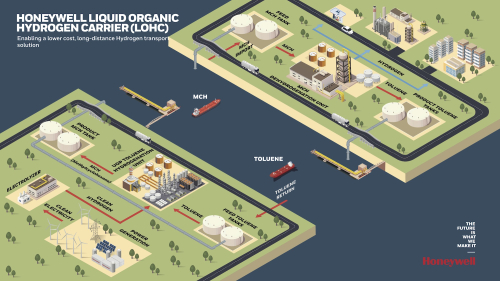
While hydrogen is expected to play a critical role in reducing greenhouse gas emissions, at standard conditions, it is a flammable gas with low density and cannot be transported efficiently in a gaseous form. Current solutions for transport include liquified hydrogen and chemical carriers such as ammonia, which would require additional infrastructure to accommodate new volume. Honeywell UOP’s LOHC solution utilizes existing refining assets and infrastructure to create and transport the carrier.
In the Honeywell LOHC solution, hydrogen gas is combined chemically through the Honeywell UOP Toluene Saturation Process into a convenient liquid carrier compatible with existing infrastructure. The carrier can then be transported in the same way as gasoline or similar hydrocarbons.
Once at its destination, the hydrogen is recovered from the carrier using the Honeywell UOP Methylcyclohexane Dehydrogenation Process. Existing idle oil refining assets can be revamped to release the hydrogen from the liquid carrier for use in multiple commercial and industrial applications. The carrier used in the Honeywell LOHC solution is readily available and requires minimal makeup.
LOHC is part of Honeywell’s Green Hydrogen program. The program leverages decades of research and development and experience in developing and manufacturing market-leading membranes and catalysts for gas processing, refining, steel, and petrochemical industries, as well as the experience in the most recent development of novel membranes for battery and power applications.
Honeywell recently committed to achieve carbon neutrality in its operations and facilities by 2035. About half of Honeywell’s new product introduction research and development investment is directed toward products that improve environmental and social outcomes for customers.